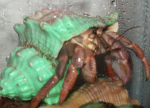Post by Angela on Jan 24, 2010 2:53:58 GMT -5
Molting is a very stressful process for your hermit crab and sometimes even kills it. However, it is essential for the life of your hermit crab, because it enables your crab to grow.
Underground molts
Underground molts are when your hermit crab buries itself underneath the substrate in order to molt. The majority of your molts will be underground molts if you provide adequate and proper substrate (at least an inch deeper than your largest hermit crab's height and not gravel.)
In order to make tunnels, your substrate must be kept moist, and it must be a type of substrate that is suitable for creating tunnels.
When the hermit crab is done molting and is ready, it will dig back up to the surface and resume living on the surface of the substrate. Your hermit crab will be stressed right after molting, so it is vital to provide a completely stress-free environment for your hermit crab after molting.
Surface Molts
Surface molts rarely occur and are usually due to the crab either having to dig up during the molting process or being unable to dig down at all. They are very stressful to the hermit crab, and other crabs may cannibalize the molting crab, which is why it is imperative to place molting crabs in the isolation tank immediately after you notice your hermit crab molting. Provide your hermit crab with everything you'd provide it while it was molting, though it will be in a much lesser need for these things.
Be sure to place your isolation tank in a stress-free area away from loud noises and leave the crab go. Darkness will also help your hermit crab have a successful molt. Do not attempt to mist the tank unless necessary; it will become more stressed if misted excessively.
Symptoms of Molting:
-Eating and drinking much more than usual
-Growing gel limbs where normal limbs once were
-Cloudy eyes
-Dampening the substrate by spilling water all of it (this softens it for molting and also prepares it for making tunnels)
Underground molts
Underground molts are when your hermit crab buries itself underneath the substrate in order to molt. The majority of your molts will be underground molts if you provide adequate and proper substrate (at least an inch deeper than your largest hermit crab's height and not gravel.)
In order to make tunnels, your substrate must be kept moist, and it must be a type of substrate that is suitable for creating tunnels.
When the hermit crab is done molting and is ready, it will dig back up to the surface and resume living on the surface of the substrate. Your hermit crab will be stressed right after molting, so it is vital to provide a completely stress-free environment for your hermit crab after molting.
Surface Molts
Surface molts rarely occur and are usually due to the crab either having to dig up during the molting process or being unable to dig down at all. They are very stressful to the hermit crab, and other crabs may cannibalize the molting crab, which is why it is imperative to place molting crabs in the isolation tank immediately after you notice your hermit crab molting. Provide your hermit crab with everything you'd provide it while it was molting, though it will be in a much lesser need for these things.
Be sure to place your isolation tank in a stress-free area away from loud noises and leave the crab go. Darkness will also help your hermit crab have a successful molt. Do not attempt to mist the tank unless necessary; it will become more stressed if misted excessively.
Symptoms of Molting:
-Eating and drinking much more than usual
-Growing gel limbs where normal limbs once were
-Cloudy eyes
-Dampening the substrate by spilling water all of it (this softens it for molting and also prepares it for making tunnels)

